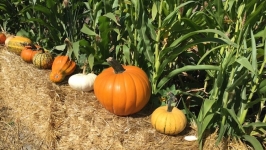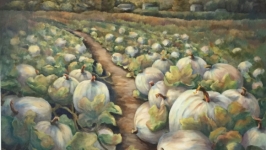What's Trending In Pumpkins From the World's Pumpkin Capital
Half Moon Bay Farmers Set World Pumpkin Trends for Both Cravings and Carvings
Rembrandt, Edison, Cinderella, Baby Boo, Casper, Cinnamon Girl—these are just a few of the wonderfully whimsical names of pumpkin varieties grown in the urban agricultural oasis of Half Moon Bay, San Mateo County’s very own “Pumpkin Capital of the World.” Traditional carving pumpkins are round and orange—any kid knows that—but these days the humble Cucurbita squash comes in a host of unusual hues and shapes. From white to green to blue and even black, the latest crop of pumpkins stand tall, small, squat, square, pointy and are bedecked with ribs, grooves, stripes, warts and all!
Unique pumpkins have become coveted décor items, according to famed local grower and leading pumpkin spokesperson Farmer John. “We’re always looking for new and rare types of pumpkins and buy seeds from all over the world.” The likes of Martha Stewart and the Ritz-Carlton have purchased from the vast array of pumpkins offered at Farmer John’s pumpkin farm in Half Moon Bay.
Just like changing trends in fashion, certain varieties become the seasonal must-have pumpkin. Pale pink Porcelain Dolls were popular last year. Farmer John predicts the “in” pumpkin this fall will be the striking pink- and blue-green striped Rembrandt.
Pumpkins aren’t just pretty, they’re delicious and nutritious—lots of fiber and beta carotene, and their seeds are rich in potassium and protein. So what’s the best pumpkin to eat? All pumpkins are edible, but the bigger carving varieties have lower sugar content, with thin walls and stringy flesh. For baking, Farmer John suggests Sugar Pie, Long Island Kabocha and Cinderella. For the best seeds, hull-less seed pumpkin varieties such Kakai and Styrian are ideal for roasting because they don’t have an outer shell, and you can easily eat the whole seed. But feel free to munch on some toasted seeds from your carved jack-o’-lanterns, just don’t eat the flesh, it’s no longer safe for cooking or eating.
Whether to adorn your porch or table or to star in a luscious aromatic pie, know that the world-class variety grown here in the Bay Area can satisfy all your craving and carving needs for fall delights.



